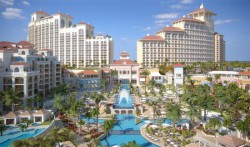When the contractors tell you that second home construction is driving the current activity in the construction sector they have to be believed or at least be taken seriously.
John Christie of HG Christie described the importance of the second home market to the economic as “major”. And it is a position echoed by Terrence Knowles, chairman of the Bahamas Contractors Association (BCA).
“Absolutely, it’s a primary driver in the construction industry,” Mr. Knowles said in a telephone interview on Tuesday.
Although major projects such as Atlantis’ Phase III and the planned Baha Mar project for Cable Beach bring in large sums, he said, they last a relatively short period of time compared with the second home market.
“You need the big projects like Atlantis or Baha Mar,” he said, “but many of the second home projects last for ten years. Projects like Baker’s Bay and Winding Bay are 10-year projects that usually generate as much as $20 million a year in construction so that provides steady employment.”
He pointed out that although he did not have any statistics to support the view he would not at all be surprised if there was a correlation between high construction activity and relatively low levels of criminal activity.
“The construction industry is labour- intensive,” said the general manager of the electrical contracting company, Flameless. “And the majority of the jobs are unskilled and semi-skilled. When a project employs 2,000 or 3,000 jobs at a time that is significant.”
He said that approximately 70 percent of the jobs in the construction industry are unskilled and semi-skilled.
“If you look at the peaks and valleys of the industry you would probably find a correlation in criminal activity,” he said.
The point, though not normally considered, has merit. The demographics for both construction and criminal activity have significant points of congruence – young, male, high school graduate and unemployed.
Mr. Knowles explained how the second home market was evolving. He noted that practically all the new developments such as Winding Bay and Baker’s Bay, both in Abaco, were communities centered around a ‘club house’.
The development usually includes a golf course, a marina, a restaurant and other amenities.
Franklyn Wilson, a principal in south Eleuthera’s Cotton Bay Estates and Villas said that what they were trying to do in Eluethera is “create a community”.
“The first phase is 25 two and three bedroom villas and we are selling lots as well,” Mr. Wilson said. “There is also a club house with full amenities.”
Although Mr. Knowles had no figures on the actual number of new homes, he did say that the construction industry could not survive on commercial projects such as office buildings.
“Apart from Kerzner’s big project there are only one or two small commercial projects – the one at Montagu and City Markets on Cable Beach, in the $5 million range and these end within 24 months,” he explained. “You can’t support the construction industry on $5 million projects. And this is why the second home market is critical to the industry.”
The BCA is not without its challenges. Over the past decade it watched its members being squeezed out on the big resort projects – Sun International, Our Lucaya, Emerald Bay in Eleuthera – in favour of foreign contractors.
But happily the situation has changed today from what it was back in the mid- nineties.
“Today we have many more Bahamian contractors involved in Phase III than they were in the earlier phases and Baha Mar on Cable Beach has committed itself to using Bahamian contractors,” he said.
By: C. E. HUGGINS, Nassau Guardian Senior Writer



